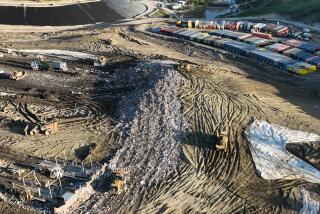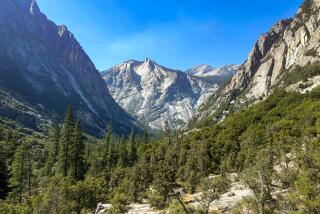2 Canyon Views in Contrast : Santa Clarita: The gorge is ugly and expendable, according to the company that wants to build a landfill. To environmentalists, the remote site features nature at its finest.
I recently toured two canyons.
One was a rocky gully laced with power lines and notable only for acres of dry scrub, smelly pools of standing water and sticky, black tar dripping from crevices.
The other was a scenic gorge carpeted with lush ferns and vivid wildflowers and sprinkled with butterflies, fossils and waterfalls, including a 55-foot chute.
Both descriptions fit Elsmere Canyon, a crescent-shaped furrow near Santa Clarita that waste-disposal firm BKK Corp. wants to turn into a 190-million-ton garbage dump. Seen through the eyes of BKK guides and anti-dump groups, both giving tours of the canyon this summer, Elsmere looks--and feels--like two entirely different places.
From the perspective of BKK executives, who led a reporter and a photographer on a three-hour tour in a four-wheel-drive vehicle, the narrow trough just east of the Antelope Valley Freeway near San Fernando Road appears worth sacrificing. No reasonable person aware of the torrent of garbage pouring out of Los Angeles, they contend, would begrudge the transformation of such an ugly, inaccessible place into a carefully terraced landfill planted with native vegetation and shielded from public view by a nearby ridge.
But from the viewpoint of several citizens’ groups, whose opposition to the dump is bolstered by the Santa Clarita City Council, Elsmere is a valuable habitat that must be saved from contamination. At risk, opponents contended during an eight-hour hike, is not only the canyon’s wildlife and vegetation, but Santa Clarita’s ground water.
An environmental report on the proposal is scheduled for completion early next year, the first step in a complex review process that involves several agencies, including the federal government, since more than half of the 2,850-acre area lies in the Angeles National Forest. If the dump is approved, the Los Angeles County Board of Supervisors and the Los Angeles City Council have agreed to buy out BKK at an estimated profit of $125 million. In that case, BKK would have laid the groundwork for the facility, which the county and city would operate as a source of revenue.
The following is a tale of two canyons:
Seven of us pile into a maroon van so littered with Coke cans and scraps of paper as to resemble a Lilliputian landfill. We’re heading up a dirt road leading to Elsmere from the east end of San Fernando Road with five dump foes.
Minutes into the ride, we run out of gas, turn around and chug downhill to a nearby gas station.
Taking the opportunity to grab a quick breakfast, the party breaks for snacks. “My mother always said food tastes better outside,” says Santa Clarita Mayor Jill Klajic, as Bill Bastanchury unwraps a sandwich, oblivious to the gas fumes.
Twenty-three dollars of unleaded later, our journey resumes, but so do our difficulties. “You’d need a machete to get through this brush,” says Dean Ferrandini, a movie director who is making a half-hour documentary about Elsmere.
Unable to penetrate the thick chaparral guarding the bottom of the canyon near a waterfall the group wants to photograph, we are forced to take a much longer hike to reach it.
A gurgling stream wends its way along the floor of the canyon, and we follow it for more than three hours on our quest to see the falls. The group has already taken a video of the cascading water and shown it during a recent Santa Clarita City Council meeting to marshal support for the Elsmere preservation effort.
Despite the 90-degree weather, we’re sheltered from the heat by some of the canyon’s more than 3,000 oaks. But there are also huge clumps of poison oak, and members of the party, although dressed in long sleeves, long pants and gloves for protection, repeatedly brush against the plants.
Yellow butterflies flit in the sunlight, and a peacefulness descends over the group as the sun climbs high above the canyon walls. Klajic points out deer tracks, an aquamarine bird egg, snail fossils and brilliant orange tiger lilies that poke out over the stream.
“They say there is nothing here to destroy, but this is a special place,” Klajic says. “Every time we bring people here, we have a new convert.”
The waterfall is still flowing when we finally reach it, though the volume of water has diminished with the onset of the dry season. Ferrandini uses a long rope to measure the length of the falls from the top of the rocky chute to the pool of water at the bottom dotted with water lilies. It is 55 feet.
“It’s a shame to lose a waterfall like this when they’re so rare,” says Pat Saletore, a homemaker and local activist.
On the way back--tired, hot and sweaty--the dump foes point out what they say are fault lines from past earthquakes to demonstrate the instability of the area. Then we pass an outcropping of rocks clustered with fossils located in a 2,150-acre area that would serve as a buffer zone for the 700-acre landfill. BKK may set aside part of the zone for a public park.
But the dump opponents are not impressed with the notion.
“Who wants to go to a park next to a landfill?” Saletore says. “When half of this canyon is already in a national park?”
If the first tour was a gold mine for companies that make calamine lotion and other poison ivy treatments, then the BKK tour doesn’t make them a penny.
Instead of crawling around in the brush, we are ensconced most of the time in an air-conditioned sports utility vehicle, complete with car phone. Ken Kazarian, whose family owns BKK, and project manager Valerie Marshall are showing us a different aspect of Elsmere.
Our drive takes us along old utility roads the company has graded to conduct geological and other tests. Huge transmission towers glitter harshly in the sun, making a constant crackling noise like hyperactive crickets. From atop the canyon, Elsmere looks like a bleak dust bowl strewn with rocks and stubby brush.
The waterfall and lush stream are more than a mile to the north, deep in the heart of the canyon, which we don’t visit on this trip. On the other hand, the anti-dumpers did not include the transmission towers on their tour.
Kazarian pulls out an aerial photograph of the area that illustrates its close proximity to the Antelope Valley Freeway. If the project is approved, the company will build a new freeway interchange, so commuters trying to get onto the highway would not have to compete with 24-hour-a-day garbage trucks, he says.
In contrast, there are 3 1/2 miles of city streets between the freeway and BKK’s dump in West Covina, he says. “Elsmere is remote, but not too remote,” Kazarian says.
A third-generation garbage man, Kazarian, 43, stands on a ridge above the canyon expressing enormous enthusiasm for Elsmere, but as an engineering challenge that calls on humankind’s amazing ability to move mountains with machinery.
Not only is Elsmere ordinary, he says, but the algae-covered pools we park next to at the mouth of the canyon are “nasty,” “smelly” and “already contaminated” with naturally seeping oil. The so-called waterfalls are just “rocky chutes,” he says. Mosquitoes buzz around his head as he talks, and foxtails cling to his white socks. There are no butterflies here.
There are nice areas of Elsmere, he concedes, as we turn back toward the city in air-conditioned comfort, but they are outside the actual landfill area. If a park is established in the buffer zone, “it’s not like you’ll walk in and immediately get knocked down by the odors,” he says. “Landfill odor control is a pretty sophisticated business these days.”
As far as wildlife goes, “if they figured out how to go under the freeway when Highway 14 went in, then they’ll figure out how to go around the landfill,” Kazarian says.
But Kazarian concedes that he will never convince dump opponents that Elsmere is expendable.
“You would think there are relics of Noah’s ark up there from the way they talk,” he says. “But there is nothing unique about this site. The entire San Gabriel Mountains are like this.
“Yet the best way to make a place like this an Eighth Wonder is to propose putting a landfill on it.”
More to Read
Sign up for Essential California
The most important California stories and recommendations in your inbox every morning.
You may occasionally receive promotional content from the Los Angeles Times.









